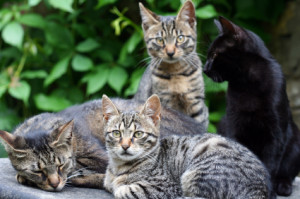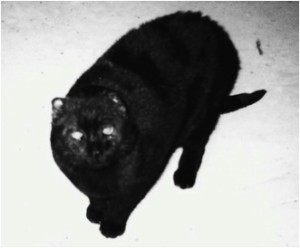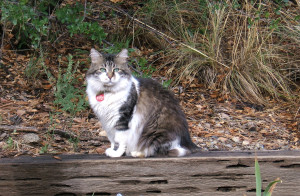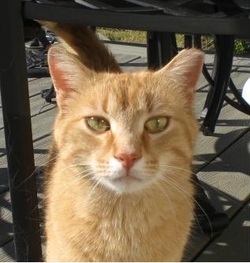(This article also published in American Pet Magazine and Species Link Journal)
I’ve recently been inspired by the efforts of a local rescue group, Red Rose Inspiration for Animals, which is developing a Trap-Neuter-Release program for feral cats in our community (Sedona/Verde Valley, AZ). Feral cats are some of the most misunderstood animals in our society, and I’ve been thinking a lot about the feral cats I’ve known and loved, and who have been some of my greatest teachers.
My relationship with feral cats has made me a better person and a better animal communicator. Here’s our story.
Freddie, My Cat Teacher
Long, long ago, in a galaxy far, far away, I was on the faculty of a large educational institution tucked away in the pine forests of the Midwest. Our campus was located close to a state park, which was a common “dumping zone” for unwanted animals. Many would show up on campus, seeking food from the cafeteria dumpsters and the kindness of humans–especially the young humans who had a habit of dropping their chips and peanut butter sandwiches everywhere they walked.
Many of these animals were cats, and not surprisingly, most were not spayed or neutered. Consequently, there was a longstanding and ongoing cat overpopulation problem on campus, as the stray and feral cats had litter after litter of kittens. Periodically, the cat colonies were “handled”–exterminated–using a variety of not-so-humane methods. And then more cats would move into the territory, and cycle would start all over again.
One day, a particular cat caught my attention outside the building where I worked. He was a black tom, had no ears, torn eyes and a scarred face, and a scruffy, dull coat. It was winter, and it was very, very cold outside. My heart went out to this cat, and I was determined to see if I could help him.
Fast forward a few weeks, and the black cat, Freddie, was living in my garage. I’m a bit embarrassed to admit that he got his name from the infamous Freddie of the horror movie…you know the one…because he was, at that time, a “slasher kitty”. I couldn’t approach him or touch him without thick leather gloves to protect my arms and hands, and he would hiss and spit and flail at me with his fully-armed-and-of-course-not-properly-trimmed claws.
He bit. He slashed. He was, on the whole, really, really nasty.
And I loved him.
I loved this cat with all of my heart. I knew, somehow, somewhere, that we had a deep soul connection. That we were meant to be together. That he was mine.
Freddie tested positive for FIV. At that time (more is known about this virus now), the wisdom was that he should be kept separated from my other cats to minimize the risk of infecting them. So Freddie lived in my garage…and later in a small addition…and with time…
…Freddie became my dearest, closest friend. He sat on my lap, let me kiss him and stroke him, and slept in my arms.
This doesn’t happen with cats who are truly feral. What I understand now is that Freddie wasn’t feral–he was a domestic cat who had been socialized once, but had been on his own for a long, long time. He had a tough life on his own and had learned aggressive defenses–but once he made a decision to live the life of a cat who has a relationship with humans, he dropped most of his aggressiveness and became my teacher, my spiritual advisor, and my very best friend.
Freddie and I would sit for hours and just hang out together. We communicated telepathically; he shared deep wisdom, understanding, and his sweet love with me. When he was diagnosed with renal failure and needed subcutaneous fluids to keep him comfortable, he would climb on my lap and we would have a sweet communion while I gave him his injection. He never complained. He never minded. Being with me, sharing our love and our deep relationship, was worth it all to him.
Freddie became a lap cat, but he always hissed at me. It became our little inside joke. He would hiss at me, I would hiss back at him, and we would laugh and laugh. Years later, when a close friend of mine, also a professional animal communicator, talked with Freddie in the spirit world, he said, “tell Nancy, HISS. That’s it. Just HISS. She’ll know what I mean.”
After a few years, Freddie’s FIV brought his body down, and he passed into the spirit world in the year of my 40th birthday.
Two years later, Freddie came to me in a clear vision on New Years’ Day, and said, “It’s time. This is the year. This is the year you step onto your path and start becoming a professional animal communicator.”
And I listened to him. I listened to Freddie because I trusted him more than I had trusted anyone in my life. He knew. He knew everything.
Freddie continues to be one of my greatest spiritual guides. We communicate daily, and he continues to teach me and guide me, always reminding me of the power of love. Usually, his guidance is gentle and loving…but when necessary, I hear that unmistakable, kick-in-the-pants HISS.
Feral Cat Rescue and TNR
Because of my experience with Freddie, I was determined to help the other stray and feral cats in my workplace and in my community. I learned all I could about ferals, including the benefits of a managed Trap-Neuter-Release (TNR) program, and I implemented a program with the help of a few like-minded friends.
We set and checked traps, and worked with a local veterinarian who donated spay-neuter services. We vaccinated and ear-tipped and released the cats back into their habitat. When there were kittens, we bottle fed them if we got them young enough; we handled them and socialized them if we could. Several cats ended up in the traps who were socialized to humans but homeless, and we worked with a local rescue group to find them homes. (My cat, Maddy, who is still with me, was one of those cats–he started as a “foster” and never left.)
I made a ton of mistakes. I had feral cats ricocheting off my garage walls and living for days under the hood of my car. I trapped skunks, squirrels, and raccoons instead of cats. I had a lot of claw and teeth marks on my body and got used to being kind of bloody.
Over time, I learned a lot about handling (or not handling) feral cats, how to tame and socialize kittens, how to trap and release cats safely and with minimal trauma for them and danger to me.
The cat population on campus stabilized. There were fewer and fewer litters. We set up feeding stations, where possible, which kept the cats out of the dumpsters. This pleased the powers-that-be. Our little TNR program was successful.
And I learned from the cats. I learned so much.
I learned the unique pleasure of helping an animal live her own, free life, without the requirement to interact with humans. I learned the joy of seeing the food bowl empty in the morning and knowing that the cats had full bellies.
I loved seeing the ferals around–at a distance–doing what cats do–living their lives freely, and with better health than they might have had were I not involved. I learned how to love an animal without requiring anything in return.
Most importantly, I learned how feral cats think. I learned how they feel. The cats taught me what life was like from their perspective. This was some of my “graduate school” training in animal communication.
The feral cats taught me about accepting them exactly as they are, with no requirements for them to be any certain way or to change. My reward for this understanding and acceptance was their willingness to communicate with me about their lives, their purpose, and their unique spiritual wisdom.
The Spiritual Wisdom of Feral Cats
As my animal communication practice grew, I talked to many feral and semi-feral cats–some with rescue organizations, some in homes, and some in my neighborhood. And what I learned from them continued to surprise and inspire me.
Turns out, many feral cats are aware that they have a particular spiritual mission here on earth. Each animal is an individual, and so this is not true across the board for every single feral cat, but over and over again, many of them would tell me:
We are not here to have a relationship with humans. We are not interested in having relationships with humans. It’s not just because we are afraid and have not been socialized to humans, although that is the physical reality of our lives. Many of us came into this life knowing that we are wild animals…and have a particular job to do…and a relationship with humans is not part of it. We don’t wish to live in homes. We don’t wish to be companions. This would be distracting for us. We are here for other reasons. We often live close to human society, but we are not part of it.
Many of the cats showed me that they are doing particular, powerful work with the Earth’s energies. One of them said,
I balance the energies of the earth. Balance, balance, balance. Many of us do this work. It involves laying on the earth, in the soil, and balancing the magnetic lines of the earth. We feel these lines and these vibrations through our bodies, particularly through the pads of our feet and our bellies, and also through our whiskers. Our bodies are exquisitely sensitive calibrating instruments. We do this work as we live our lives–walk our territory, hunt our prey, live in our cat communities and raise our families. Our lives may often be short, but we do intense, powerful work while we are here. We are very aware of our mission and our purpose, and the gifts that we bring to the earth.
I am connected with many other cats all over the world who have a similar mission. We have a highly developed collective consciousness within our colonies and our species. We are very aware of the work that we have come to do, and we appreciate being able to do it in peace.
As I’ve continued to work with and communicate with feral cats, I’ve come to appreciate their unique wisdom and perspective, and the great awareness and spiritual teaching that they are able to transmit.
TNR Basics: Working with Feral Cats
What is a Feral Cat?
It’s important to distinguish between stray cats, who have been socialized to humans, at least at some point in their lives, and who may regain their socialization, and feral cats, who have not been and will not be socialized to humans and who will not be able to live as companion cats. Many feral cats have been born to feral mothers, and the feral behaviors and colony life may go back for many generations.
Alley Cat Allies, an American national advocacy organization for feral cats, has a great page with identifying characteristics to help to distinguish between stray and feral cats: Stray or Feral?
What is TNR?
Trap-Neuter-Release (TNR) is widely accepted as the most humane solution to managing feral cat populations and decreasing cat overpopulation. The basics of TNR include:
- Trapping cats using humane live traps. There are even special traps that allow a cat to be treated by a veterinarian without having to be handled.
- Spaying/neutering/vaccinating against rabies by a veterinarian skilled in handling feral cats.
- Ear-tipping: Ear-tipping is an effective and universally accepted method to identify a spayed or neutered and vaccinated feral cat. It is performed under anesthesia at the same time that the cat is spayed/neutered. Ear-tipping is the removal of the distal one-quarter of a cat’s left ear, which is approximately 3/8 inch, or 1 cm, in an adult and proportionally smaller in a kitten.
Ear tipping provides immediate visual identification, which alerts animal control and humane groups that a cat is part of a colony. It also helps colony caretakers track which cats have been trapped and altered, and identify newcomers who have not.
- Release: After recovery from spay/neuter, cats are released to their previous home territory, when possible. If home-territory release is not possible, cats are acclimated to a new territory where the colony will be provided food, water, shelter, and colony management.
- Colony management: feral cat groups/colonies are managed by caregivers, who supply feeding stations, shelter where appropriate, and monitor the colony for any new arrivals who will then be cared for using TNR.
- Population stabilization: in time, a managed colony will all be sterile, new cats will usually not come into the territory, and breeding and giving birth to new litters of kittens stops. Cats are cared for for the duration of their lives.
If you are interested in starting a TNR program to help feral cats in your community, see the resources below.
Telepathic Communication Tools for Working with Feral Cats
You can use telepathic communication, the universal language that all species share, to help you in working with and understanding feral cats. Here are some tips:
- Accept that feral cats are not domestic animals. They are much more like wild animals and if they are truly feral, and not stray cats, will not ever be tamed or socialized to people.
- Respect feral cats for who they are. Don’t require them to like you, to interact with you, or to include you in their lives. If they do, consider it a great honor. You may find that they will allow you to observe their cat society from a distance, which can be a very beautiful experience. Accept them for who they are, and thank them for their presence in the world.
- Recognize that even if feral cats do not wish to interact or socialize with humans, they can and do receive telepathic communication from humans. Even if you are not confident in your ability to receive communication from them, trust that they can and do receive communication from you.
- Send communication clearly and responsibly to feral cats you are working with. You can do this by simply getting quiet, and focusing your feelings, heart, and intentions on communicating with the cats. Send them clear emotions of understanding, respect, and compassion. if you are trapping cats, you can send them pictures of being treated quickly and gently, being released, and being cared for in their territory with a supply of food, water, and shelter. You can also let them know if there are dangers to be avoided where they are living.
- To send communication clearly and responsibly, do your best to keep any strong emotions that you may be feeling out of the picture. Send your intentions and communications peacefully and calmly, with a gentle, honest, and respectful attitude toward the cats.
- Express your gratitude to the cats for who they are and the special gifts that they bring to the world. Thank them for allowing you to be a part of their lives from a distance, and honor them with your respect and compassion.
Beginning Animal Communication Online Class Information
Feral Cat Resources
For more information on working with feral cats, both through TNR and through telepathic communication, here are some resources:
Animal Communication Tools for Shelter and Rescue Workers
This is my free 60-minute class on using telepathic communication in shelter and rescue situations. You can listen to it through my website or download it free for future reference.
Alley Cat Allies
Alley Cat Allies is the only national advocacy organization dedicated to the protection and humane treatment of cats. An engine for social change, Alley Cat Allies was the first organization to introduce and advocate for humane methods of feral cat care, particularly Trap-Neuter-Return, in the American animal protection community.
This website contains a ton of information and resources for people who work with feral cats.
Best Friends Animal Society Community Cat Program
Includes resources and educational info on TNR for individuals and rescue groups, as well as links to programs around the country.
Humane Society of the United States
The resources on this website include a free downloadable handbook on Trap-Neuter-Return.
Getting Started with Animal Communication Kit
You can receive this free kit, which includes and E-Book, “10 Tools for Telepathic Communication with Animals” and an mp3 meditation recording, “Open Your Heart to the Animals,” by signing up for my newsletter in the sidebar!
Beginning Animal Communication Online Course is now available! You can begin your journey with animal communication from the comfort of your home.






